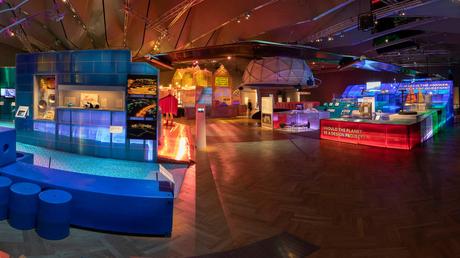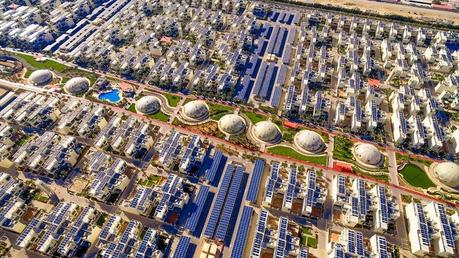Was it really? The above is a mangled abbreviation of a quote from sci-fi author William Gibson. The full version (“The future is already here. It’s just not evenly distributed yet.”) is much beloved of people who work in ‘futures thinking’ (I’m avoiding the labels ‘futurists’ and ‘futurologists’). Occasionally, yes, this statement does come through as a pretty good way of looking at the world.
My latest reinforcement of its validity came when I visited a recent exhibition at the V&A rather impressively titled ‘The Future Starts Here – 100 projects shaping the world of tomorrow’. I record my impressions through a series of observations.
Firstly, I should acknowledge that it was a good excuse to go to the V&A and inspect the new entrance – a rather interesting mixture of textures with different shades of white stone, as well as some fine wood structures (but those was only temporary, I think).
Then there was the descent into the exhibition space itself – a dark area with no natural daylight – is that telling about what is envisioned for the future? But luckily there was lots of lighting and color to bring out the exhibits around which you gradually wound your way.

Unsurprisingly, there were the obligatory techie items – robots, AI, smart objects that capture and analysis data – but also, later on, objects which are low-tech versions of the technologies we now have come to rely on – phones and internet access. I applaud a view of the future which sees the need for regression as well as progression in innovation.
There were a fair number of objects which were familiar to me, either the items themselves or the core concepts behind them. Examples include a restaurant setting meant to be inviting to the increasing number likely to be living ‘single’ and thus wanting to be able to eat out alone without feeling uncomfortable. There was also a bottle of Soylent on the table too – not sure about that one.
There was also a special personal cleansing care range, designed in response to the fact we now go to considerable effort to stay very clean and effectively remove all bacteria and dirt from the skin, despite the fact, just like the inside of our bodies, our skin also relies on good bacteria to be healthy. Hence the need for Motherdirect, which uses special bacteria called AOB (Ammonia Oxidizing Bacteria) to help convert the irritating components of sweat and turn them into beneficial byproducts like Nitrite and Nitric Oxide, which help to calm and soothe the skin.
Motherdirt was an item that is already being commercialised. There were some exhibits that have been in existence – conceptually at least – for many years but as a completed project, remain indefinitely in the future. See here a fabulous city – clean and smart – which uses the latest technologies and will be completely powered by the sun, or something like that.

There were objects that are more about hope than rigorous assessments of what might be possible in the future. In contrast to the shiny technology devices, one case contained the pink ‘pussy hat’ which was developed to make a bold and powerful visual statement of solidarity in support of women’s rights and against Trump, ideally to be worn at the Women’s Marches that have taken place in numerous countries in recent months. Yes, a symbol for hope because Trump is still around and who knows how much has actually changed for women?
My final observation is very simple – I have chosen it to illustrate the fact that looking ahead into the future, we have to recognize that actually lots of how we live we still be very similar. There are certain aspects of everyday living which are remarkably resistant to change, in particular what we eat and drink. There was an exhibit displaying a coffee machine designed by Lavazza to allow people in space to still be able to have a good cup of coffee. Probably quite important actually!
Advertisements